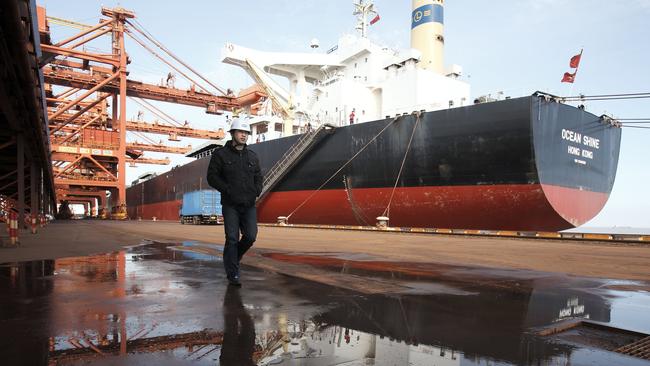Iron ore breaks $US100 a tonne, back to boom time
A brief scare over a perceived China threat to iron ore exports put a dent in mining stocks on Thursday.

A brief scare over a perceived China threat to iron ore exports put a dent in mining stocks on Thursday, but Australia’s major producers are still raking in cash as the iron ore price again nudges $US100 a tonne.
Iron ore futures traded on the Dalian futures exchange tipped over the $US101 a tonne mark on Thursday, and spot prices for iron ore grading 62 per cent hit a nine-month high of $US98.20 a tonne in Shanghai trading.
And the rampant spread of the coronavirus in Brazil could push iron ore prices back above $US120 a tonne, according to Morgans analysts Adrian Prendergast, given strong steel production figures from China.
China Iron and Steel Industry Association deputy director Wu Jing Jing told a Singapore Exchange forum on Monday he expected a strong rebound for the country’s industry in the current quarter, despite an earlier plunge in demand for steel from the real estate, automobile and manufacturing sectors.
Mr Wu told investors on the call that China’s steel output, lifting after temporary COVID-19 interruptions, would be absorbed by domestic infrastructure projects, and that excess steel inventory was now subsiding.
And iron ore inventories at Chinese ports are still falling, to below 110 million tonnes this week — well below levels of about 160 million tonnes in mid-2018, with steel production still rising.
Brazilian miner Vale has had its slowest start to exports in four years, according to Mr Prendergast, shipping 91 million tonnes since the start of the year, almost 30 per cent below the 129 million tonnes shipped in 2017, the peak of its performance.
For Vale to reach even the bottom of its revised 310-330 million tonne 2020 production guidance, the Brazilian major would need to ship 7.2 million tonnes a week for the rest of the year — well above current rates of about 4.2 million tonnes. “Add this to steadily declining iron ore stockpiles in China, and potential new stimulus measures that could be announced in China later this week,” Mr Prendergast said in a client note.
That bodes well for Australia, despite minor hiccups in local production — the most recent a temporary halt at BHP’s Jimblebar mine in the Pilbara after a spate of low-level safety incidents.
Just over a year ago, as iron ore approached $US95 a tonne in the wake of Vale’s tailings dam disasters, Rio Tinto boss Jean-Sebastien Jacques said a $US10 a tonne rise in the average iron ore price would yield an extra $US2bn a year in free cash flow from the company’s Pilbara operations.
A year later that equation looks even better for Rio and its Pilbara competitors, given the sharp falls in both the Australian dollar and the price of diesel, a major factor in the cost of running the Pilbara’s iron ore mines.
Fortescue Metals stock hit all time highs of $14.13 this week, with Rio and BHP also benefiting from the rising iron ore price.
Shares in iron ore majors took a hit on Thursday as a change to China’s import regime — to remove mandatory inspections of inbound cargoes in favour of testing and sampling on the request of an importer — was cast as a threat to Australian producers by state-owned media sources amid rising trade tensions.
The Global Times of China quoted a Chinese academic as saying the move was an “implicit threat” to Australia over ongoing trade tensions sparked by Scott Morrison’s push for an independent investigation into China’s response to the coronavirus outbreak.
But Fortescue and BHP were quick to play down the change in the customs regime, saying the changes had been long-planned, and introduced after extensive consultation with Australian exporters and their Chinese customers.
Both said the new customs rules would likely make it faster for iron ore shipments to clear Chinese ports and make their way to local steel mills.
Fortescue shares closed down 30c to $13.60, with BHP down 21c to $34.51 and Rio Tinto off 97c to $93.19.


To join the conversation, please log in. Don't have an account? Register
Join the conversation, you are commenting as Logout